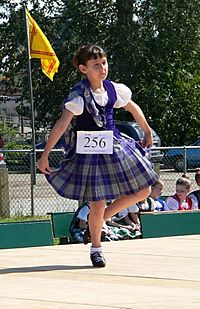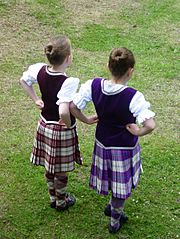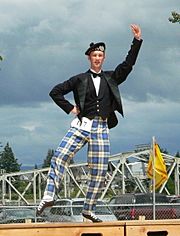Scottish Highland dance facts for kids
Highland dance, also called Highland dancing, is a special type of competitive dance. It started in the Scottish Highlands in the 1800s and 1900s. You often see it at public events like the Highland games. This dance style grew from older Scottish folk dances. But it became more formal, taking some ideas from ballet. Highland dancing is usually done to the music of Highland bagpipes. Dancers wear special shoes called ghillies. Today, you can find Highland dancing at almost every modern Highland games event.
It's important not to mix up Highland dance with Scottish country dance, cèilidh dancing, or clog dancing. Even though these dances might also be performed at Highland games, they are different styles.
Contents
What is Highland Dancing?
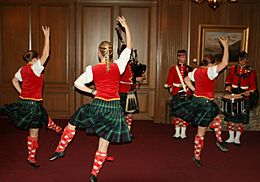
Highland dancing is a competitive and technical dance. It needs a lot of skill, energy, and strength. The Sport Council of Scotland even recognizes it as a sport!
In Highland dancing, dancers usually dance on the balls of their feet. It's a type of solo step dancing. This means dancers perform by themselves. Unlike some step dances that only use foot tapping, Highland dancing uses a mix of steps. It also includes movements of the upper body, arms, and hands.
Highland dancing is different from Scottish country dancing. Scottish country dancing is a social dance, meaning you dance with a partner or a group. It's also a formation dance. This means the patterns of group movement on the dance floor are important, like in square dancing.
Some Highland dances did come from traditional social dances. For example, the Highland Reel, also known as the Foursome Reel. In this dance, groups of four dancers take turns doing solo steps facing each other. They also do a figure-of-eight movement. But in competitions, Highland Reel dancers are judged one by one. Most Highland dances are danced solo.
Scottish Dance vs. Irish Dance
Many people think Scottish Highland dance and Irish dance are the same. But they are two very different styles. Even though some dance schools teach both, they have different rules and costumes.
In Scottish Highland dance, dancers use their arms, often raising them above their shoulders. Their legs and feet are usually turned out at a 45-degree angle. They mostly wear soft shoes called ghillies.
In Irish dance, dancers rarely use their arms, keeping them close to their bodies. Their legs and feet are often crossed. They frequently use hard-soled step shoes. Irish dance also uses more planned choreography than traditional movements.
History of Highland Dance
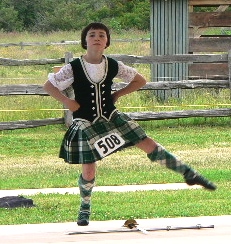
Modern Highland dancing became popular in the 1800s and 1900s. It was created from older Scottish folk dances but made more formal, like ballet.
It seems that different kinds of sword dancing were done by warriors in many parts of Europe a very long time ago. Sword dances are also mentioned in the late Middle Ages. These dances often copied brave deeds and fighting skills. They were a common part of Scottish traditions.
One of the first mentions of these dances in Scotland is from a book called Scotichronicon in the 1440s. It talks about King Alexander III's wedding in 1285. Musicians played pipes, including bagpipes. Behind them, people performed a "war-dance with intricate weaving in and out."
In 1573, Scottish soldiers reportedly performed a Scottish sword dance for the Swedish King, John III. This dance was part of a plan to attack the King. The dancers could show their weapons without anyone suspecting anything. Luckily for the King, the signal to attack was never given.
Sword dances and Highland dances were also part of celebrations for important people. They were performed for Anne of Denmark in Edinburgh in 1590, and for James VI in 1617, and Charles I in 1633.
In 1747, the British government tried to stop Highland culture. They passed the Act of Proscription, which made it illegal for men to wear kilts. This law was removed in 1782. In the early 1800s, people started to become very interested in Highland culture again. This interest grew even more with Queen Victoria's support. This led to the start of the Highland games as we know them today.
Highland dancing was a big part of the Games from the very beginning. However, only certain dances were chosen for competitions. This meant many older dances were forgotten because they weren't needed for competing. The way these competitions were set up also changed the style of the dancing itself.
Dance Organizations
Before the 1900s, most dancing was not organized across countries. Judges at competitions were local people. They didn't have specific rules for costumes or dance steps. Local Scottish societies taught young dancers their own ways. Slowly, dance steps became more consistent, and special dance organizations were created.
Today, dancers can take written tests and practical exams to become teachers. They can then get more training to become dance examiners or competition judges.
Royal Scottish Official Board of Highland Dancing (RSOBHD)
Many Highland gatherings around the world recognize the Royal Scottish Official Board of Highland Dancing (RSOBHD). This group was formed in 1950. It is the main governing body for Highland dancing worldwide. In 2019, the Queen of the United Kingdom approved the use of "Royal" in its name.
The RSOBHD made dance steps standard for competitions. It also set rules for competitions and costumes. It certifies competitions and dance instructors. The RSOBHD World Highland Dance Championship has been held every year at the Cowal Highland Gathering since 1934. Today, this championship has three levels: Juvenile (youngest), Junior, and Adult. Only dancers registered with the RSOBHD can compete in this championship.
The RSOBHD includes representatives from many different Highland Dancing groups from around the world. These include teaching associations and organizations from Australia, Canada, South Africa, New Zealand, and the United States.
The RSOBHD approves Highland dancing championships, but it doesn't organize them. There are also championships run by groups not connected to the RSOBHD. Dancers registered with the RSOBHD are not allowed to take part in these non-RSOBHD competitions. If they do, they might be banned by the RSOBHD. Similarly, dancers not registered with the RSOBHD cannot dance at RSOBHD-approved competitions. Each year, the RSOBHD chooses the championship steps for dancers worldwide. They have also published an official RSOBHD Highland Dance technique book.
Other Dance Groups
Other organizations that train Highland dancers, teachers, and judges, and hold competitions include:
- The Scottish Official Highland Dancing Association (SOHDA)
- The New Zealand Academy of Highland and National Dancing
- The Victorian Scottish Union (Australia)
These groups offer a wide range of Highland and national dances in their teaching programs.
Highland Games and Competitions
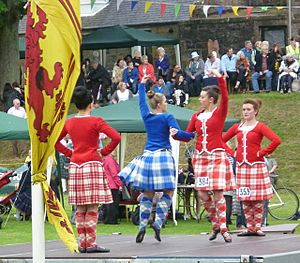
At Highland games, Highland dances were first performed only by men. Women took part in social dances. Girls learned solo dances as part of their regular dance classes. Dance teachers often encouraged their best students, male or female, to perform solo dances at their end-of-term shows.
In the late 1800s, a young woman named Jenny Douglas decided to enter a Highland dance competition. Since there was no rule against it, she was allowed to compete. Since then, more and more females have joined the sport. Today, over 95% of all Highland dancers are female. Several female World Champions have been crowned at the Cowal Highland Gathering since 1948. The first international dancer to win the Adult World Championship was Flora Stuart Grubb from Australia in 1960. Hugh Bigney was the first American to win the title in 1973. The first three Adult World Championships were won by women: May Falconer (1948), Margaret Samson (1949 and 1950). Even with more women dancing, men are still well represented at the world championships.
Highland dancing competitions can be held on their own or as part of bigger events. The small annual Scottish Glen Isla competition is held by the roadside, next to piping and heavy games events. Canada's Glengarry Highland Games is one of the biggest dancing and piping events in North America. Many Australian competitions are held indoors. Canadian and Scottish competitions are often part of Highland games, with a nearby hall in case of bad weather.
Until the early 1900s, the main dances seen in competitions were the Sword Dance, the Seann Triubhas, the Strathspey and Highland Reel, the Reel of Tulloch, and the Highland Fling. Since then, other dances have been added. For example, two character dances, 'The sailor's hornpipe' and 'The Irish jig', became popular in music hall shows.
Judging Highland Dance
Most judges today look at three main things when scoring a dancer: timing, technique, and interpretation.
- Timing means how well the dancer follows the rhythm of the music.
- Technique is about doing the steps correctly. It also includes how the rest of the body moves, like the head, arms, and hands.
- Artistic interpretation is about the dancer's ability to show feeling and understanding of the dance. It's about how they express the art form.
- Judges also look at the dancer's overall ability, including how high they jump and their confidence.
The different Highland dancing organizations set the rules for the dances and how dancers are scored. They also decide how dancers move up in skill levels. In competitions, each dancer starts with 100 points. Points are taken away for mistakes or poor execution. Dancers are then ranked from most to fewest points. Medals and points are given based on how many dancers are in the group.
The way dances are performed has changed a lot over the years. For example, if a dancer did an early 1900s style sword dance today, they would likely be disqualified. There used to be a lot of confusion about what was allowed. Then the RSOBHD created a standard that most competitive dancers now follow.
Types of Highland Dances
Scottish Highland dances are generally put into different groups. These groups help organize them but aren't strict styles:
- Highland dances (like the Highland Fling and Sword Dance)
- National dances (like the Scottish Lilt and Flora MacDonald's Fancy)
- Character dances (like the Sailor's Hornpipe and Irish Jig)
Step dancing and clog dancing also used to be part of some competitions.
The steps for each dance are now written down in national and international guides. These include textbooks from the RSOBHD, United Kingdom Alliance Ltd (UKA), and British Association of Teachers of Dancing (BATD). Each dance has several steps. For example, a four-step Highland Fling might use the 1st step, 7th, 5th alternative, and finish with the 8th step. Or they might be called by their names, like Shedding or Double Shake and Rock.
Highland Dances
The Highlander developed these dances as a way to practice using a broadsword. This included dancing over two swords laid on the floor. Dancers would move quickly around them, carefully placing their feet between the blades. This has long been linked to dances done before a battle or as a victory dance.
A legend says that before a battle, the Highland chief would ask the best dancers to perform the sword dance. If they danced without touching the blades, it was a sign that their clan would win the battle. A more practical idea is that this dance helped sword students practice their footwork. They would follow patterns marked on the floor.
In another type of Scottish sword dancing, the Highlander danced on a shield. This is similar to an old Roman exercise where a man on a shield had to defend himself while others tried to pull it away. Many old Highland dances, now lost, were performed with traditional weapons. These included the Lochaber axe, broadsword, targe (a small shield), dirk (a dagger), and flail. Old songs, like 'Buailidh mi thu anns a' cheann' (I will strike your head), suggest some form of weapon play to music.
The Highland Dirk Dance involves the dancer showing off a weapon. It's often linked to the sword dance or dances called 'Mac an Fhorsair' (son of the Forester) or 'Bruicheath' (battle dance). These dances are mentioned in military records. They might have been performed by two people fighting, or as a solo routine.
The tune of Gille Chaluim (Gillie Callum) is said to be from the time of Malcolm III of Scotland (1031–1093). But this claim was likely made up to make the dance seem older than it is. The dance probably wasn't invented before 1800. One story says the crossed swords were placed on the ground before a battle. If a soldier's feet hit the swords, he would be hurt in battle. This might come from old warrior stories. But the style of the dance was changed by the Maclennan brothers of Fairburn.
One idea about the Highland Fling is that it was a dance of victory after a battle. Another idea is that it was performed before battles (like the sword dance) on top of the dancer's shield. The shield would have a spike in the middle. The dancer would do the dance around this spike, flicking their feet, jumping, and stepping carefully. This was supposedly to scare away evil spirits. The dancer stays in one spot and snaps their fingers. (Today, dancers just hold their hands with the thumb touching the middle finger, and the other three fingers extended). It's hard to imagine dancing around a sharp spike on a shield. A more likely idea is that the Highland Fling is a Foursome Reel with the group parts removed. At social gatherings, dancers would show off their fancy solo steps. This happened long before formal competitions at Highland games began.
Another story about the Fling says it imitates a stag (a male deer). The story goes that a boy saw a stag. When his father asked him to describe it, the boy danced instead. The position of the hands in the dance looks like the head and antlers of a stag. This story hides the fact that Highlanders used to snap their fingers when they danced.
Ruidhle Thulaichean (The Reel of Tulloch) is said to have started in the churchyard of Tullich, Aberdeenshire. People were waiting for the minister, who was late. While waiting, they whistled a Highland tune and started to make up a dance.
The Seann Triubhas means 'old trousers' in Gaelic. It's often linked to the government removing the ban on wearing the kilt after the failed Jacobite Uprising of 1745. However, the dance is much newer. Most of the steps done today are from the late 1800s.
Like other dance traditions, what we call 'Highland dancing' is a mix of old and new. It has changed over time to fit new ideas and interpretations of the past. While some parts might be centuries old, others are much more modern. Most of the dances performed today were created in the 1900s.
Highland dances are now joined at Highland Games and dance competitions by what are called National dances. In Highland dancing, every dancer wears a kilt, or tartan trews (trousers). Male dancers wear jackets, ties, and 'bonnets' (hats). Female dancers wear blouses with vests or jackets.
National Dances
At Highland games, National dances include the Scottish Lilt, the Earl of Erroll, Blue Bonnets, Hielan' Laddie, the Scotch Measure, Flora MacDonald's Fancy, Village Maid, and Barracks Johnny. These dances show the history of dancing and other parts of Scottish culture. Some National dances were taught by dance teachers in the 1800s and show some ballet influence. Others come from older traditions and were changed to fit later tastes. The 'Earl of Erroll', for example, used to have tapping footwork from the 1700s. But today's Highland dancers perform it in soft Ghillies. Some National dances were kept and taught by dance teachers like D.G. MacLennan and Flora Buchan. Others were put back together in the mid-1900s from notes written in Frederick Hill's 1841 manuscript.
For National dances, female dancers might wear a white dress with a tartan plaid over their right shoulder. Or they might wear the more popular 'aboyne' dress. The aboyne dress has a velvet top over a white blouse. It has a tartan or tartan-like knee-length skirt and white underskirts. A tartan 'plaid' is worn with a Scottish brooch pinned to the shoulder and waist. They may also wear skin-colored tights or white socks.
Character Dances
The sailor's hornpipe was taken from an English dance. It is now performed more often in Scotland. The Irish Jig is a funny imitation of, and tribute to, Irish step dancing. The dancer wears a red and green costume. They act like an Irish person, showing anger and frowning. If a woman or girl dances the Irish jig, it's about a wife scolding her husband, a woman bothered by leprechauns, or a washerwoman chasing away naughty boys who dirtied her laundry. The woman showing her fist means she wants to hit them. If a man or boy dances it, it's the story of Paddy's leather breeches. A careless washerwoman has shrunk Paddy's nice leather breeches. He waves his shillelagh (a type of club) at her in anger and shows his fist, wanting to hit her.
The Hornpipe copies a sailor in the navy doing work on a ship. This includes pulling ropes, sliding on the rocking deck, and getting his paycheck. The dance has many details that show the character. For example, the dancer doesn't touch their palms (which are supposed to be dirty) on their uniform. It's performed in a British sailor's uniform. Its name comes from the musical instrument that goes with it, the hornpipe. It's danced to tunes like "Crossing the Minch" and "Jackie Tar."
One of the most unusual character dances in modern Highland dance competitions was the cakewalk. The cakewalk was originally a dance performed by black slaves in the southern US. They would imitate, in a funny and exaggerated way, the fancy ballroom dancing of slave owners. It was the only dance in competitive Highland Dance always performed by two people. It was also the only dance that didn't come from the British Isles. Dancers often wore creative and sometimes wild costumes. While costumes for other dances are very specific, cakewalk dancers tried to come up with the most imaginative duo costumes. For example, they might dress as Frankenstein and his bride, or Mickey and Minnie Mouse. The cakewalk was usually only danced at very big competitions, like national championships. It was generally for the top level of competitive dancers. The cakewalk was usually performed to 'Whistling Rufus'. The inclusion of the cakewalk in competitive Highland Dance is credited to James L. McKenzie, who brought the dance to Scotland from the United States. In 2021, the RSOBHD decided to remove the dance from competitions. They did this because it was considered offensive to people of color.
Hebridean Dances
The 'Hebridean dances' came from the Hebrides islands. Highland dancers now perform them. We don't know when these dances started or who created them. But a dance teacher named Ewen MacLachlan taught them in the Western Isles in the mid-1800s.
These dances include Aberdonian Lassie, Blue Bonnets, Over the Water to Charlie, Tulloch Gorm, Flowers of Edinburgh, Scotch Measure (Twa'Some), and First of August. Many other dances from the Hebrides have been partly or completely lost. Hebridean dances are more relaxed than other Highland dances. They have also been more influenced by step-dancing.
List of Dances
This list does not include every dance. Dances marked with an asterisk ('*') are often seen at RSOBHD competitions.
Highland Dances
- Pas de Basques *
- Pas de Basques and high cuts *
- Highland Fling *
- The Marquis of Huntly’s Highland Fling
- Sword dance *
- Sword Salute
- Argyll Broadswords
- Lochaber Broadswords
- Jacobite Swords
- Seann Triubhas *
- Hullachan *
- Strathspey and Highland Reel *
- Strathspey and Half Tulloch *
- Strathspey, Highland Reel and Half Tulloch
- Threesome Reel
- Tulloch Gorum
National and (soft-shoe) Step Dances
- Blue bonnets over the border *
- Earl of Erroll (reel) *
- Flora MacDonald's Fancy *
- Highland Laddie (Hielan' Laddie) *
- Scotch Measure (Twa Some) *
- Scottish Lilt *
- Village Maid *
- Wilt thou go to the barracks, Johnny? *
- Tribute to J. L. McKenzie
- Aberdonian Lassie
- Betty's Jig
- Bobby Cuthbertson
- The Bonnie Briest Knot
- Bonnie Dundee
- Dancer's Delight
- The Dusty Miller
- The First Of August
- Flowers of Edinburgh
- Hebridean Laddie
- The King Of Sweden
- Lady Louisa MacDonald of Sleat
- Lassies Of Kyle
- Linkumdodie
- Louden Lassies
- Miss Forbes
- Mrs MacLeod of Raasay
- Over the Isles to America
- Over the Water to Charlie
- The Thistle
- Tribute to Charlie Mill
Character Dances
- Cakewalk (no longer in competition)
- Irish jig *
- Sailor's hornpipe *
Highland Dance Costumes
Each dance organization (like RSOBHD, SOHDA, VSU) sets its own rules for costumes. Some things, like lipstick, earrings, face glitter, and rings, might not be allowed depending on the group.
Here's what you commonly see dancers wear. Costumes have changed over the years. Ruffles around the neck and wrist cuffs used to be common. Long-sleeved kilt jackets might be replaced by short-sleeved ones depending on the weather. A dancer's skill level or gender can also affect the costume. For example, under RSOBHD rules, Premier-level dancers have more specific costume items than newer dancers.
Highland Dance Attire
Boys and men wear a traditional Scottish hat called a Balmoral. They also wear a doublet, which is a jacket made of colored velvet or cloth. If the jacket is in the 'Prince Charlie' style, it's worn with a shirt and bow tie, and a waistcoat, cummerbund, or belt. 'Montrose' style jackets are worn with a white lace jabot (a frilly neckpiece) and sometimes sleeve ruffles. A kilt and matching tartan hose (socks) are worn with a sporran (a small pouch). Tartan trews (trousers) can be worn instead of a kilt for the Seann Triubhas dance.
Girls and women wear a tartan kilt with a velvet jacket. This jacket is worn with a lace insert, or a sleeveless velvet vest worn over a white blouse. The jacket or vest can be black or colored. It often has gold or silver braid and buttons down the front. Matching tartan hose are also worn.
National Dance Attire
Boys and men wear the same clothes for National dances as they do for Highland dances. However, tartan trews can be worn instead of a kilt.
Girls and women might wear a white dress with a tartan plaid over their right shoulder. Or they can wear the more popular 'aboyne' dress. The aboyne dress has a velvet top over a white blouse. It has a tartan or tartan-like knee-length skirt and white underskirts. A tartan 'plaid' is worn with a Scottish-themed brooch pinned to the shoulder and waist. They may also wear skin-colored tights or white socks.
Sailor's Hornpipe Attire
Both boys and girls wear the same outfit for the sailor's hornpipe. It can be navy blue or white. A v-neck jumper is worn over a square-necked white vest. They also wear bell-bottom trousers. A navy or light blue collar (with three stripes) and a sailor's cap are also worn. In the past, the trousers used to have horizontal creases.
Irish Jig Attire
Irish jig shoes are black, green, or red. They look a lot like ghillies, but they are hard-soled shoes with heels.
Boys and men wear a Paddy hat, a red or green muffler (scarf), and a tailcoat. They also wear brown or khaki breeches (short trousers) and a waistcoat (vest) in a different color from the tailcoat. A shillelagh, which is a type of Irish club, is carried for twirling.
Girls and women can wear different combinations of red, green, and white blouses, dresses, skirts, and cummerbunds (sashes). Dancers also wear white underskirts and a white apron.
See also
 In Spanish: Danza de las tierras altas escocesas para niños
In Spanish: Danza de las tierras altas escocesas para niños
- Clog dancing
- Dirk dance
- Highland dress
- Aboyne dress
- Highland games
- Irish dance
- Scottish country dance
- Step dancing
- Scottish sword dances
- Ghillies
- Specific highland dances
- Highland fling
- Seann triubhas


